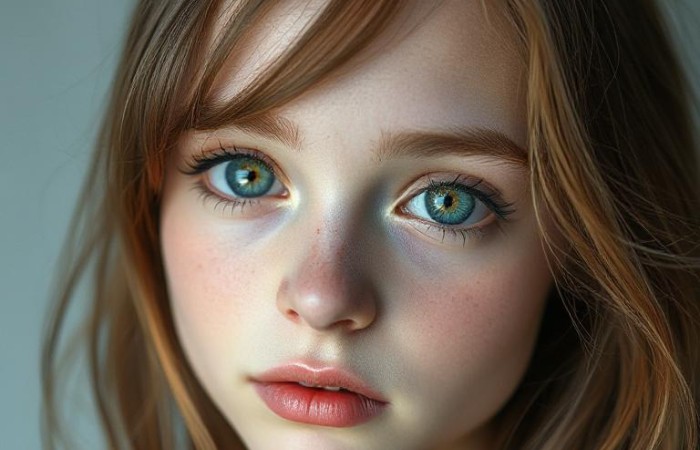The comparison between central heterochromia and hazel eye colors remains an unclear subject in eye color studies. The two conditions produce elegant color mixtures, although they result from distinct causes and display distinct differences. This article unveils distinguishing characteristics that most resources fail to discuss between these two conditions.
Table of Contents
What Is Central Heterochromia?

WebMD explains that central heterochromia represents a unique case of iris malformation that creates two different eye colors: a dominant ring surrounds a pupil-centered contrasting spike. People with this condition display blue eyes, but their pupils are surrounded by a golden-brown color. The development of uneven melanin occurs genetically or because of minor trauma, which leads to this condition.
Hazel Eyes: A Blend of Colors
Eye color science indicates that the exact name of hazel eyes differs from the hazel hypothyroidism vs hazel distinction because these eyes feature unified gold and brown and green pigment patterns. Rayleigh scattering and moderate pigment levels yield this observation through light reflection from melanin. Hazel eyes do not display the distinctive color boundary that characterizes central heterochromia.
Key Differences Between Central Heterochromia vs Hazel Eyes
| Feature | Central Heterochromia | Hazel Eyes |
| Color Distribution | Two distinct colors with sharp boundaries | Uniform mixture of colors without boundaries |
| Appearance | Noticeable dual-colored iris | Blended colors that may shift under lighting |
| Causes | Genetic factors leading to uneven melanin distribution | Moderate melanin levels and Rayleigh scattering |
| Prevalence | Relatively rare | It is more common, especially in specific populations |
The Overlooked Differences
- The lighting determines the appearance of hazel eyes, yet the two colored sections inside the eye remain constant in central heterochromia.
- Medical professionals consider central heterochromia benign unless it indicates severe syndromes such as Horner’s. Hazel eyes are purely cosmetic.
- The unusual eye color of central heterochromia leads to its frequent mystical interpretations in artistic and cultural contexts. In contrast, hazel eyes frequently attract romantic visualization because of their changing spectral characteristics.
The Genetics Behind Eye Color
The production of melanin through gene variations leads to both central heterochromia and hazel eye color formation. Specific genes control the distribution of melanin into circular patterns in the iris when they manifest central heterochromia. Hazel’s eye appearance develops because multiple genes control how melanin gets distributed across the complete iris and its total production levels.
Enhancing Your Eye Color
Enhancing your distinctive eye features exists through multiple options regardless of whether your eye color is central heterochromia or hazel.
- Makeup Tips: Using complementary eyeshadow colors becomes a helpful technique to draw attention to your eye hues. People with central heterochromia should select colored eyeshadows that present distinct contrasts between their eye colors. Warm-toned make-up works best for hazel eye characteristics because it enhances their heat-like properties.
- Fashion Choices: The proper selection of fashion items that match your eye color will result in increased visibility of your features. Jewel-toned colors look beautiful on individuals with both central heterochromia and hazel eyes.
- Eyewear: Frames that enhance eye color should be your selection when choosing eyewear. The use of explicit or pale frames adds additional attractiveness to the eyes while making sure they stand out without creating distractions.
Why Most People Confuse the Two?
Color blending occurs in both situations, although it is confusing. The rings of central heterochromia become distinguishable from hazel when closely inspected because central heterochromia shows a defined ring, whereas hazel reflects a gradient-like fusion.
Unique Perspectives and Insights
From a genetic and scientific perspective, central heterochromia and hazel eyes maintain additional cultural value and personal impact. Unusual eye colors throughout history have received artistic, literary, and mythical admiration. People with central heterochromia or hazel eye color often receive curiosity and admiration from others regarding the rare uniqueness of their eye appearance. Both central heterochromia and hazel eyes demonstrate our genetics produce diverse human characteristics. Human eye colors represent unique markers that help us understand what makes each person different and reveal the aesthetic value of our eclectic nature.
Final Thoughts
An understanding of central heterochromia and hazel help increase respect for eye diversity patterns. Those who stare into hazel eyes marvel at their color-changing abilities, yet central heterochromia stands out in its impressive dual appearance. Forward this educational material to individuals who need help identifying different eye features.
